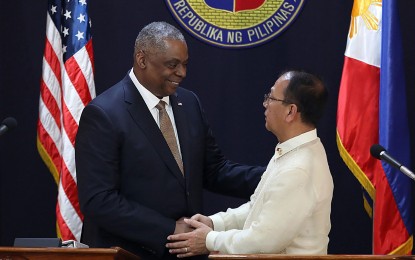US Defense Secretary Lloyd J. Austin III (left) and Department of National Defense chief Carlito Galvez Jr. (right) (File photo)
MANILA – The Bilateral Defense Guidelines between the United States and the Philippines have emphasized that an attack in the Pacific, including any part of the South China Sea against public vessels, aircraft or armed forces of the two nations will result in the invocation of the Mutual Defense Treaty (MDT) commitments.
“The guidelines reaffirm that an armed attack in the Pacific, including anywhere in the South China Sea, on either of their public vessels, aircraft, or armed forces – which includes their Coast Guards – would invoke mutual defense commitments under Articles IV and V of the 1951 US-Philippines MDT,” it added.
The guidelines were established on Wednesday by Defense Secretary Lloyd J. Austin III and his Filipino counterpart Carlito Galvez Jr.
“Recognizing that threats may arise in several domains – including land, sea, air, space, and cyberspace – and take the form of asymmetric, hybrid, and irregular warfare and gray-zone tactics, the guidelines chart a way forward to build interoperability in both conventional and non-conventional domains,” it noted.
The Bilateral Defense Guidelines also aims to modernize alliance cooperation in service of the United States and the Philippines’ shared vision for a free and open Indo-Pacific Region.
The guidelines are informed by the following goals with the aim of strengthening the United States and the Philippines’ combined deterrence in an evolving security environment, including:
— Reaffirm the US-Philippines MDT’s enduring relevance in addressing both current and emerging threats;
— Foster a common understanding of roles, missions, and capabilities within the framework of the alliance to face regional and global security challenges;
— Drive unity of effort across all areas of bilateral security and defense cooperation to sustain focus on principal regional security concerns; and;
— Guide priority areas of defense cooperation to address both conventional and non-conventional security challenges of shared concern.
The guidelines identify multiple lines of effort to advance these objectives, including the following:
Modernizing defense capabilities
— Coordinate closely on the Philippines’ defense modernization, including through the completion of a Security Sector Assistance Roadmap, to identify priority defense platforms and force packages that will bolster combined deterrence and capacity to resist coercion.
— Prioritize the procurement of interoperable defense platforms sourced from US programs and Philippine national defense procurement and funding initiatives.
— Expand investments in non-materiel defense capacity building including through education and training exchanges, exercises, and other operational activities.
Deepen interoperability
— Orient bilateral exercises and activities around improving our combined ability to counter armed attacks on either country as well as threats in space and cyberspace, while expanding the scope, scale, and complexity of exercises.
— Expand cooperation on maritime security and maritime domain awareness, including through the continued conduct of combined maritime activities, including but not limited to joint patrols.
— Deepen cooperation under the Enhanced Defense Cooperation Agreement (EDCA) to strengthen interoperability, including through infrastructure improvements; enhanced joint use of facilities; advancement of additional maritime security, maritime domain awareness, and humanitarian assistance and disaster relief capabilities; and rotational US access to agreed locations.
— Enhance bilateral planning and information-sharing.
— Conduct coordinated analysis, tabletop exercises, and training and exercises to reinvigorate bilateral planning and coordination efforts; assess bilateral requirements; and advance common objectives and approaches to shared challenges.
— Develop adaptable decision-making processes and communication procedures to support flexible, timely, whole-of-government bilateral coordination and action to respond to conventional and unconventional warfare.
— Broaden information sharing on early indicators of threats to the peace and security of both countries to ensure preparedness to address principal challenges confronting the alliance.
— Strive toward real-time information sharing in collaboration with other departments and agencies to support deeper interoperability and operational coordination.
— Enhance information security through consultations on policies, practices, and procedures for the protection of classified defense and military information.
Combat transnational and non-conventional threats
— Improve cyber defense and cyber security cooperation to secure critical infrastructure and protect against attacks emanating from state and non-state actors.
— Pursue capacity-building activities to respond to chemical, biological, radiological, and nuclear-related attacks and to counter the proliferation of weapons of mass destruction. Contribute to global and regional peace and security.
— Sustain participation in multilateral fora, anchored in shared support for ASEAN centrality.
— Prioritize trilateral and other forms of multilateral cooperation based on common issues of shared concern, including pursuing opportunities for third-party participation and observation in bilateral US-Philippine defense activities.

